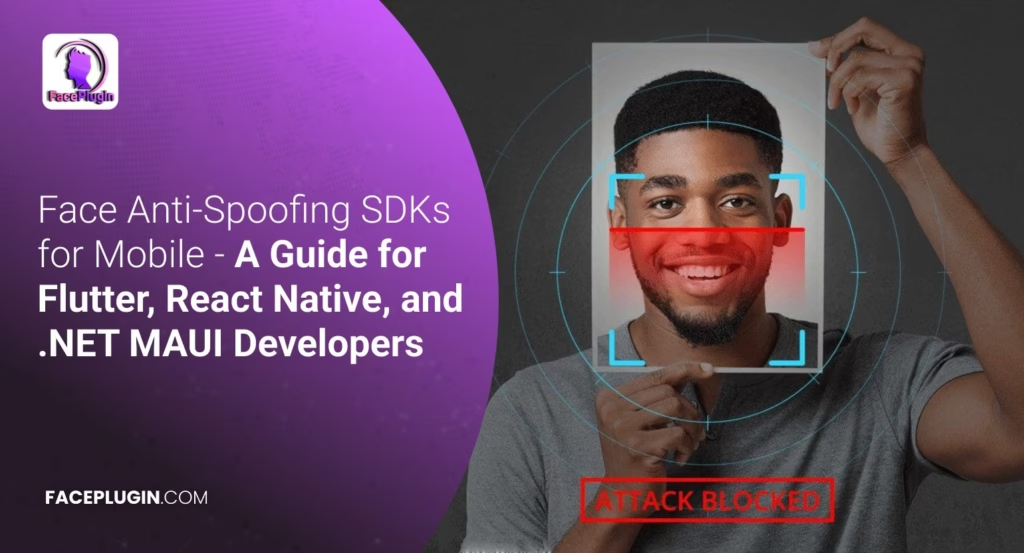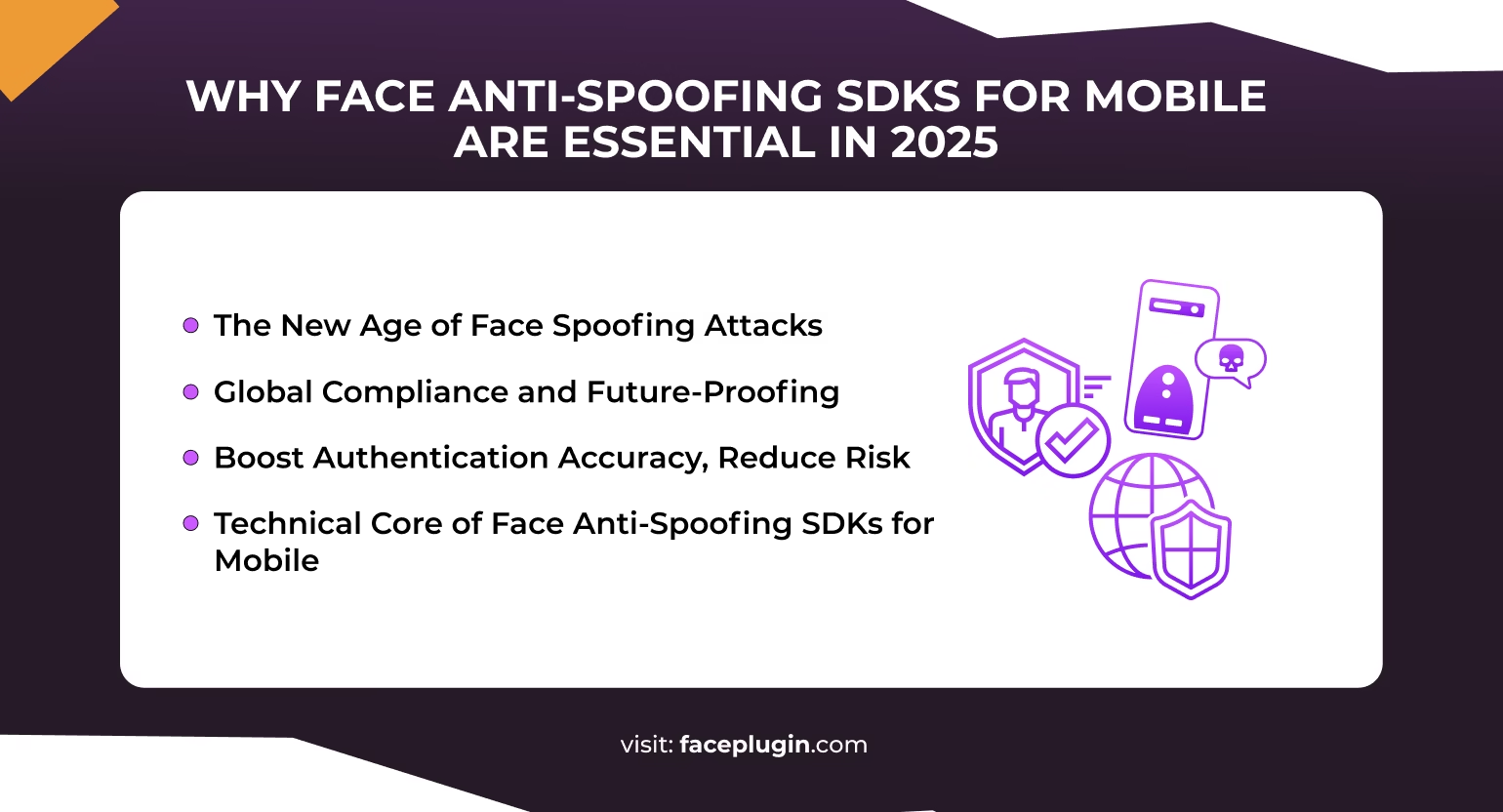Face Anti-Spoofing SDKs for Mobile are no longer optional; they’re mission-critical for any modern application that relies on biometric security. With the surge in mobile-based authentication systems, from banking to healthcare to ride-sharing apps, face recognition is now the front line of user identity verification.
But with convenience comes vulnerability. Sophisticated spoofing attacks using photos, videos, 3D masks, and even deepfakes are making headlines, exposing users and businesses to serious risks.
In this escalating digital threat landscape, Face Anti-Spoofing SDKs for Mobile offer the most robust defense. These SDKs don’t just detect faces; they confirm if the face is live, human, and present in real time.
Using technologies like passive liveness detection, motion analysis, and 3D depth sensing, they make biometric authentication smarter and more secure.
Today’s developers aren’t just working on one platform. They need tools that work seamlessly across Flutter, React Native, and .NET MAUI frameworks that power global-scale mobile apps. That’s where FacePlugin steps in.
As a leader in AI-powered face security, FacePlugin offers enterprise-grade Face Anti-Spoofing SDKs for Mobile that are accurate, fast, and easy to integrate across all major platforms. If your app handles user identity, this is your first and best line of defense.
Why Face Anti-Spoofing SDKs for Mobile Are Essential in 2025
As mobile threats grow, Face Anti-Spoofing SDKs for Mobile are no longer optional; they’re critical security infrastructure.
The New Age of Face Spoofing Attacks
Fraud has evolved. And it’s fast. Attackers now use:
- Deepfakes are generated via AI to mimic live users convincingly.
- 3D silicone masks that bypass outdated liveness checks.
- Synthetic identity fraud uses generated facial data to create fake users.
Basic face recognition just won’t cut it anymore. You need real, dynamic security.
Technical Core of Face Anti-Spoofing SDKs for Mobile
Face Anti-Spoofing SDKs for Mobile combine multiple biometric techniques to detect fraud in milliseconds
- Passive liveness detection checks micro-movements without asking the user to blink or move.
- 3D face mapping reconstructs real depth to verify that a face isn’t flat or fake.
- Real-time face tracking ensures the user remains continuously present.
No user effort. No delay. Just frictionless defense.
Boost Authentication Accuracy, Reduce Risk
These SDKs increase security precision:
- Minimize false positives that lock out legit users.
- Eliminate false negatives that let spoofers in.
- Adapt to real-world environments like poor lighting or shaky hands.
Results? More trusted logins. Fewer fraud claims. Happier users.
Global Compliance and Future-Proofing
You’ve got regulations to meet. SDKs follow
- ISO 30107-3: the gold standard for biometric presentation attack detection.
- GDPR and CCPA-friendly: Data can stay on-device.
Plus, these SDKs adapt fast when spoofing evolves; they patch.
What Types of Spoofing Attacks Can Mobile Face Anti-Spoofing SDKs Detect?
They catch
- Static photos and screen replays.
- High-resolution printed masks.
- AI-generated facial animations.
- Complex 3D silicone imitations.
They don’t just check “is this a face?” they ask, “is this a real face now?”
In 2025, Face Anti-Spoofing SDKs for Mobile aren’t just helpful, they’re foundational. If your app uses biometrics, this layer isn’t optional anymore. It’s your lock, key, and watchdog in one.
Integration of Face Anti-Spoofing SDKs for Mobile with Flutter, React Native, and .NET MAUI
You’ve built secure login flows, but Face Anti-Spoofing SDKs for Mobile are what make them bulletproof. Integrating them? That’s where it gets real technical and smart. In 2025, cross-platform devs need fast, scalable solutions that work everywhere.
Let’s break down how to integrate them into Flutter, React Native, and .NET MAUI apps.
SDK Architecture and Cross-Platform Backbone
Face Anti-Spoofing SDKs for Mobile work under a hybrid SDK architecture
- Built with native C++, Java, Swift, and .NET bindings.
- Offer abstracted wrappers for Flutter, React Native, and MAUI.
- SDKs support Android, iOS, and sometimes even desktop or browser.
- FacePlugin offers modular builds for seamless framework-specific use.
A strong core lets SDKs run lightweight liveness checks using device-side computation. No lag. No cloud dependency.
Flutter Integration – Plugins and Native Bridges
Flutter gives devs a single codebase, but real-time liveness isn’t pure Dart
- You’ll need a native plugin bridge for camera and face pipeline access.
- SDK packages must connect with Android (Kotlin/Java) and iOS (Swift) APIs.
- Handling permissions manually for the camera and storage gets tricky.
- FacePlugin simplifies this with a pre-built Flutter plugin and native wrappers.
Use platform channels properly, or you’ll hit performance bottlenecks during frame-by-frame face processing.
React Native Integration – Native Modules and UI Threads
React Native bridges JavaScript with native code, but
- You must write native modules to access face anti-spoofing APIs.
- SDKs like FacePlugin’s offer pre-compiled native modules to ease that pain.
- Balance real-time performance with React Native’s JS thread and UI thread.
- Camera access usually goes through react-native-camera or custom native code.
Add some async control, or your face tracking may stutter. FacePlugin avoids this with GPU-accelerated liveness modules.
.NET MAUI Integration – Scalable and Enterprise-Friendly
If you’re working inside Microsoft’s ecosystem, .NET MAUI is the native future:
- SDKs plug into MAUI using .NET bindings and dependency injection.
- Cross-platform UI abstraction still allows for native camera control.
- Supports on-premise processing, ideal for banks, healthcare, and privacy-first sectors.
- FacePlugin delivers a high-level API built for C# workflows.
Dev teams scale this easily. Full enterprise authentication layers integrated in days, not weeks.
How Do Flutter, React Native, and .NET MAUI Differ?
Flutter needs platform channels. React Native runs custom native modules. .NET MAUI handles native and UI abstraction in one go.
All need native access. But the way SDKs connect to the framework changes completely.
Why FacePlugin SDKs Win at Integration
FacePlugin’s Face Anti-Spoofing SDKs for Mobile are battle-tested:
- Work with Flutter, React Native, and .NET MAUI.
- Support Android & iOS out of the box.
- Use passive liveness detection, depth estimation, and AI face models.
- Include modular APIs and guides for each framework.
You don’t build the bridge; they already did. Just plug in and launch.
Best Practices to Implement Face Anti-Spoofing SDKs for Mobile in Your App
Getting Face Anti-Spoofing SDKs for Mobile up and running in your app isn’t rocket science, but it’s no copy-paste job either. A sloppy integration can kill performance and weaken security. Done right, though? You lock down spoofing threats and deliver frictionless user authentication. Let’s walk through a no-fluff, tech-smart implementation strategy.
Step-by-Step SDK Integration Workflow
1. Add SDK Packages to Your Project
- Include the SDKs in your dependency manager (Gradle, CocoaPods, NuGet).
- FacePlugin SDKs are modular and pre-compiled for multiple targets.
2. Configure Platform-Specific Permissions
- Request runtime camera permissions on Android and iOS.
- Don’t forget biometric and storage access if your app stores facial data.
- Add privacy descriptions in iOS Info.plist and Android AndroidManifest.xml.
3. Initialize the SDK
- Initialize the face anti-spoofing module during app startup or session auth.
- Load the model files into memory before launching the camera view.
4. Integrate the Liveness Detection Engine
- Launch the SDK’s real-time face capture view using native or cross-platform APIs.
- FacePlugin offers pre-built UI for Flutter, React Native, and MAUI.
5. Handle Results and Responses
- Capture output: Liveness score, detection flag, confidence level.
- Route successful liveness passes to the biometric verification flow.
- Block or escalate spoofing attempts for review or secondary authentication.
Tips to Boost Detection Accuracy
To get the most from Face Anti-Spoofing SDKs for Mobile, optimize hardware and environment:
- Ensure even, natural lighting, avoid shadows, and glare on the user’s face.
- Use high-resolution cameras (preferably 720p or higher) for depth detection.
- Maintain a 30fps frame rate or higher for smoother facial tracking.
Poor lighting, shaky camera, or low resolution? That’s how false negatives sneak in.
Deployment – On-Premise vs. Cloud-Based
FacePlugin SDKs support both on-device and server-side deployments:
- On-premise: Better privacy, faster real-time checks, and works offline.
- Cloud-based: Centralized processing, scalable, but may raise latency issues.
Choose based on compliance needs (GDPR, ISO 30107-3) and your app’s architecture.
What Affects SDK Performance?
The environment, device specs, frame rate, lighting, and SDK integration flow all play a role. Miss one, and accuracy drops.
Face Anti-Spoofing SDKs for Mobile work best when fully optimized from integration to deployment. Secure apps need more than just face detection; they need liveness you can trust.
Conclusion – Face Anti-Spoofing SDKs for Mobile – The Future of Trusted Identity
Face Anti-Spoofing SDKs for Mobile aren’t optional anymore; they’re foundational in protecting biometric data against modern fraud threats. From deepfakes to 3D mask attacks, mobile applications are facing smarter spoofing vectors every single day.
Developers can’t afford weak liveness checks anymore. With passive liveness detection and real-time verification built in, these SDKs shut down spoof attempts before they even begin.
Frameworks like Flutter, React Native, and .NET MAUI make it easier to build apps faster, sure. But without robust anti-spoofing mechanisms, your authentication layer stays vulnerable. These SDKs bridge that gap. They deliver cross-platform consistency and enterprise-grade security without compromising performance.
Integration might need native modules or platform-specific configuration, but the ROI on fraud reduction is worth it. Every time.
And when it comes to choosing a provider? Go where AI meets reliability. FacePlugin brings top-tier Face Anti-Spoofing SDKs for Mobile, combining passive detection, 3D facial modeling, and seamless compatibility with modern tech stacks. The SDKs scale, adapt, and defend, built by engineers who understand both real-world threats and real-world development timelines.
Secure your mobile app with FacePlugin and build safer, smarter facial authentication today. Don’t wait until spoofing hits your users. Start securing identity in the intelligent way.
Elevate Your Identity Security: Advanced Biometric Solutions at FacePlugin
Transform the way you secure and verify identities with FacePlugin, the leading provider of cutting-edge biometric authentication and ID verification solutions. Our platform is designed to meet the highest standards of security and efficiency, offering seamless integration for businesses across various industries.
At FacePlugin, we understand the importance of protecting your digital assets. That’s why we provide robust solutions, including advanced face recognition, face liveness detection (anti-spoofing), and ID document recognition technologies. Our solutions are engineered to ensure that identity verification is not only secure but also user-friendly and accessible.
Explore our range of customizable solutions, available both online and through our mobile SDKs. Whether you require on-premises or cloud-based deployment, FacePlugin has you covered with flexible options tailored to your specific needs. If you want to learn more about us, you can explore our articles on our website.
Experience the future of identity security today with FacePlugin—where innovation meets reliability. Start your journey towards enhanced security and peace of mind by visiting our website or trying our solutions online.
📍 FacePlugin – Contact & Integration Support
Head Office Address
📍 701 N. Fort Lauderdale Beach Blvd, Fort Lauderdale, FL 33304
📞 Phone: +1 (442) 229-5661
📧 Email: info@faceplugin.com
📱 Telegram: https://t.me/faceplugin
Get quotes and technical support from the expert team for smooth onboarding.





